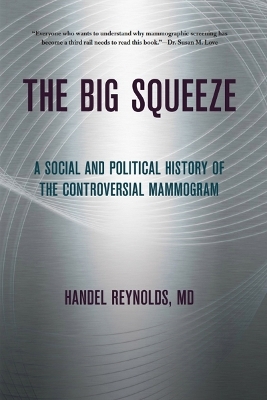
The Big Squeeze
A Social and Political History of the Controversial Mammogram
Seiten
2016
Ilr Press (Verlag)
978-1-5017-0574-8 (ISBN)
Ilr Press (Verlag)
978-1-5017-0574-8 (ISBN)
- Lieferbar (Termin unbekannt)
- Versandkostenfrei innerhalb Deutschlands
- Auch auf Rechnung
- Verfügbarkeit in der Filiale vor Ort prüfen
- Artikel merken
This concise book chronicles the often turbulent history of screening mammography since its introduction in the early 1970s.
In 2009, an influential panel of medical experts ignited a controversy when they recommended that most women should not begin routine mammograms to screen for breast cancer until the age of fifty, reversing guidelines they had issued just seven years before when they recommended forty as the optimal age to start getting mammograms. While some praised the new recommendation as sensible given the smaller benefit women under fifty derive from mammography, many women’s groups, health care advocates, and individual women saw the guidelines as privileging financial considerations over women’s health and a setback to decades-long efforts to reduce the mortality rate of breast cancer.
In The Big Squeeze, Dr. Handel Reynolds, a practicing radiologist, notes that this episode was only the most recent controversy in the turbulent history of mammography since its introduction in the early 1970s. In a book written for the millions of women who face the decision about whether to get a mammogram, health professionals interested in cancer screening, and public health policymakers, Reynolds shows how pivotal decisions made during mammography’s initial launch made it all but inevitable that the test would be contentious. He describes how, at several key points in its history, the emphasis on mammography screening as a fundamental aspect of women’s preventive health care coincided with social and political developments, from the women’s movement in the early 1970s to breast cancer activism in the 1980s and ’90s. At the same time, aggressive promotion of mammography made the screening tool the cornerstone of a huge new industry.
Taking a balanced approach to this much-disputed issue, Reynolds addresses both the benefits and risks of mammography, charting debates, for example, that have weighed the early detection of aggressively malignant tumors against unnecessary treatments resulting from the identification of slow-growing and non-life-threatening cancers. The Big Squeeze, ultimately, helps to evaluate the ongoing public health controversies surrounding mammography and provides a clear understanding of how mammography achieved its current primacy in cancer screening.
In 2009, an influential panel of medical experts ignited a controversy when they recommended that most women should not begin routine mammograms to screen for breast cancer until the age of fifty, reversing guidelines they had issued just seven years before when they recommended forty as the optimal age to start getting mammograms. While some praised the new recommendation as sensible given the smaller benefit women under fifty derive from mammography, many women’s groups, health care advocates, and individual women saw the guidelines as privileging financial considerations over women’s health and a setback to decades-long efforts to reduce the mortality rate of breast cancer.
In The Big Squeeze, Dr. Handel Reynolds, a practicing radiologist, notes that this episode was only the most recent controversy in the turbulent history of mammography since its introduction in the early 1970s. In a book written for the millions of women who face the decision about whether to get a mammogram, health professionals interested in cancer screening, and public health policymakers, Reynolds shows how pivotal decisions made during mammography’s initial launch made it all but inevitable that the test would be contentious. He describes how, at several key points in its history, the emphasis on mammography screening as a fundamental aspect of women’s preventive health care coincided with social and political developments, from the women’s movement in the early 1970s to breast cancer activism in the 1980s and ’90s. At the same time, aggressive promotion of mammography made the screening tool the cornerstone of a huge new industry.
Taking a balanced approach to this much-disputed issue, Reynolds addresses both the benefits and risks of mammography, charting debates, for example, that have weighed the early detection of aggressively malignant tumors against unnecessary treatments resulting from the identification of slow-growing and non-life-threatening cancers. The Big Squeeze, ultimately, helps to evaluate the ongoing public health controversies surrounding mammography and provides a clear understanding of how mammography achieved its current primacy in cancer screening.
The late Handel Reynolds MD was a breast radiologist in private practice in Atlanta, Georgia and former Chief of Breast Radiology at Indiana University.
Introduction: The Mammography Story1. Timing Is Everything2. First Exposure3. The Aftermath4. A Tale of Two Epidemics5. Age Is Nothing but a Number6. Pulling the Plug on Granny7. The House that Mammography Built8. Overdiagnosis: Mammography's BurdenNotes
Index
| Erscheinungsdatum | 13.10.2016 |
|---|---|
| Reihe/Serie | The Culture and Politics of Health Care Work |
| Zusatzinfo | 8 Halftones, black and white; 3 Maps |
| Verlagsort | New York |
| Sprache | englisch |
| Maße | 140 x 216 mm |
| Gewicht | 454 g |
| Themenwelt | Sachbuch/Ratgeber ► Gesundheit / Leben / Psychologie |
| Medizin / Pharmazie ► Medizinische Fachgebiete ► Onkologie | |
| Studium ► Querschnittsbereiche ► Prävention / Gesundheitsförderung | |
| ISBN-10 | 1-5017-0574-1 / 1501705741 |
| ISBN-13 | 978-1-5017-0574-8 / 9781501705748 |
| Zustand | Neuware |
| Haben Sie eine Frage zum Produkt? |
Mehr entdecken
aus dem Bereich
aus dem Bereich
Orthomolekulare Medizin in Prävention, Diagnostik und Therapie
Buch | Hardcover (2022)
Thieme (Verlag)
71,00 €
Lehrbuch zur berufsspezifischen Ausbildung
Buch | Softcover (2021)
Kohlhammer (Verlag)
46,00 €


